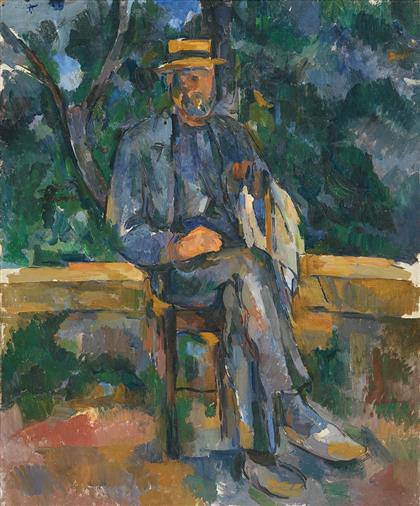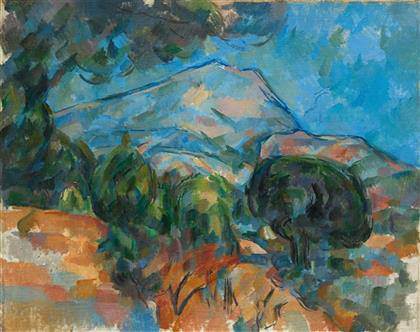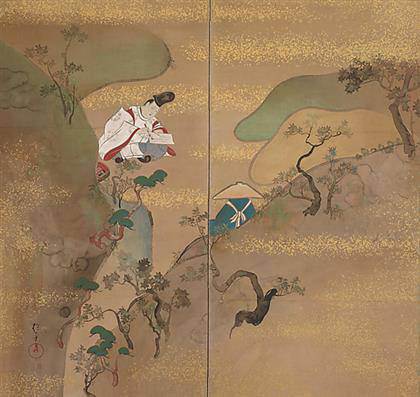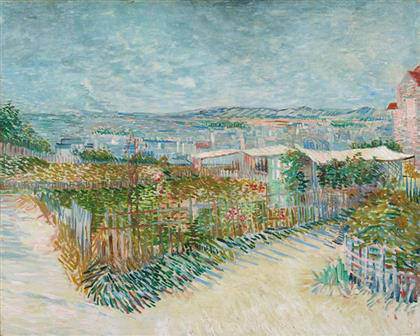
Paul Cézanne
Portrait of a Peasant, c.1905-06
Oil on canvas, 64.8 x 54.6 cm.
Thyssen-Bornemisza Museum, Madrid

Paul Cézanne
Mount Sainte-Victoire, c.1904
Oil on canvas, 72.2 x 92.4 cm.
Cleveland Museum of Art, gift of Leonard C. Hanna Jr.
Cézanne Site / Non-Site – Thyssen Museum Featuring 58 works, ‘Cézanne Site / Non-Site’ is the first retrospective on Cézanne to be held in Spain in thirty years. Thyssen Museum, Madrid, 4 February to 18 May 2014.]]>
Source: Thyssen Museum / theartwolf.com
As one of the most important painters of the history of art, a major exhibition of the work of Paul Cézanne (Aix-en-Provence, 1839-1906) is always an event of exceptional interest. “Cézanne Site / Non-Site” is a fascinating retrospective that puts an emphasis on the dialectic between the artist’s outdoor painting and his studio work.
The exhibition is divided into five sections. The first section, “Portrait of an Unknown Man”, features just one painting, the “Portrait of a Peasant” from the Thyssen Museum. A late work, the face of the old peasant is unpainted, with some scholars suggesting that the painting could be a self-portrait.
The second section of the show, “The Bend in the Road”, is beautifully explained in the exhibition’s press release: “One of [Cézanne’s] most recurring motifs is the bend in the road, which landscape painters traditionally used to attract the viewer’s gaze into the pictorial space. However in Cézanne’s painting this entry into the painting is frustrated: blocked by some trees and rocks or by the topography itself. Cézanne’s paths go nowhere.” Comparing the early “Bend in the Road Through the Forest” (1873-75, Guggenheim Museum) with the later “The Bend in the Road” (1900-06, National Gallery of Washington) is a quick way to understand the evolution of Cézanne’s style.
“Nudes and Trees”, includes three good paintings from Cézanne’s “Bathers” series. Unfortunately, the three are early versions, without the audacity of later works such as the famous versions in Philadelphia, Chicago, and London. There are some excellent forest scenes, such as “L’Estaque: Pines and Sea” (1883-85, Staatliche Kunsthalle Karlsruhe).
Along with the “Card Players” series (a notable but understandable absence in the exhibition), the paintings depicting the Mount Sainte-Victoire are the zenith of the artist’s creative powers. “The Phantom of Sainte-Victoire” includes three paintings and a watercolour from this series, which are put into relation with Cézanne’s famous still lifes. The press release explains that André Masson said of these works: “Look at these still lifes, they follow the advice of the Sainte-Victoire: they are geological.”
“Construction Game” -the fifth and last section of the exhibition- makes an interesting statement: “Just as Cézanne transformed his still lifes into landscapes, his landscapes without figures or movements can easily become still lifes“. Interesting and debatable, even considering Cézanne’s own quote about “treating nature by means of the cylinder, the sphere, the cone, everything brought into proper perspective”. In any case, Cézanne’s landscapes had an enormous influence on Cubism, as can be seen in some later works included in the exhibition, such as Georges Braque’s “The Castle at La Roche-Guyon (1909, Moderna Museet Stockholm) or André Lhote’s “Trees at Avignon” (1909, Musée d’Art moderne André Malraux, Le Havre).
“Cézanne Site / Non-Site” is on view from February 4th to May 18th, 2014. More info can be found at the Thyssen Museum’s website.
Related content
Paul Cézanne’s Card Players at the Metropolitan Museum (exhibition, 2011)
Paul Cézanne: Montagne Sainte-Victoire (series of paintings)
Follow us on:


